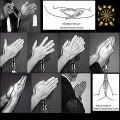There are two main kinds of chanting in Nichiren Buddhism. These are kito prayer 祈祷 and kanjin 観心 chanting meditation. Both of these are found in the writings of Nichiren Daishonin. Moreover, prayer and meditation are aspects of most forms of Buddhism. Kito Prayer is something we can do either for ourselves or for others; and others can do for us. It can take many forms. In Soka Gakkai, members often get together to pray for someone who is sick, or for the success of an activity. In some schools of Nichiren Buddhism, specially trained minsters conduct something called kito blessings. The more general Kito Prayer Daimoku done by members should not be confused with that specific kind of highly focused Kito Blessing Prayer.
Prayer chanting is something that helps us cultivate the mind of faith, known as shinjin in Japan. In the beginning, our faith might be limited to some expectation that our prayers will be answered. Once we receive answers, our conviction grows, and we develop the mind of faith. This might be similar to positive thinking. Nichiren Buddhism teaches esho funi, or oneness of life and environment. We can influence the environment, or let the environment limit us. Once we develop the mind of faith, our cheerful, confident outlook is reflected in our surroundings.
However, that is still only the relative beginning. There is also kanjin chanting meditation. This is something we can only do for ourselves. In Buddhism, there is no single word for meditation. The Buddha taught Right Effort, Right Concentration, and Right Mindfulness. There are also many methods, such as silent breath meditation, mandala contemplation, mantra chanting, and more. There are also sitting, walking, reclining meditations, and so on. The Theravadin sage Buddhaghosa taught 40 Objects of Concentration. There are several stages and sub-stages of meditation such as calming the mind, concentration, absorption, attainment, cessation, 4 main frameworks of mindfulness; {body, sensation or feelings, mental state, and mental qualities}; and the arising of wisdom-insight.
Mantra Chanting has an advantage, because it does not require a lot of training. Moreover, Kanjin Daimoku Chanting Meditation is said to be equal to the most advanced stage of insight. It also contains the merits of the others, so we do not have to go through all of those steps or stages. Kanjin Meditation can be done by simply chanting and focusing the mind, senses, and body on the sound and rhythm of the Daimoku. We can also use the Mandala Gohonzon as a visual object of concentration. Nichiren Shoshu calls this Shodai 唱題, or daimoku chanting meditation; with the purpose of achieving Kyochi Myogo 境智冥合, a sort of fusion with the Mandala Gohonzon. This is related to kanjin 観心. These practices, over time, enable one to reflect objectively on one's intentions, speech, and deeds. They also help us cultivate discerning wisdom and all embracing compassion. The ultimate objective is to manifest our inherent Buddha Nature; which is wholesome, blissful, constant, and our authentic selfless self.




